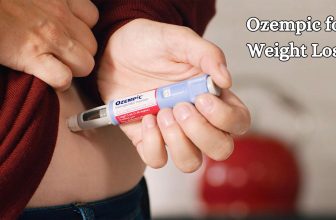How to Lose Belly Fat After Tubal Ligation? Let’s Find Out the Secret

Tubal ligation is a common surgical procedure that blocks or seals fallopian tubes to prevent pregnancy. While the procedure doesn’t directly cause weight gain or make it harder to lose weight, many women are concerned about losing belly fat after tubal ligation.
So, how to lose belly fat after tubal ligation?
To lose belly fat after tubal ligation, you need to actively engage in recovery, follow a suitable diet plan and exercise regularly. Consult your doctor, focus on whole foods, engage in aerobic and strength training exercises, track progress, manage stress, and prioritize sleep.
This comprehensive guide will explore effective strategies and lifestyle changes to help you lose belly fat and maintain a healthy weight after tubal ligation.
Recovery is Key
Tubal ligation is a surgical procedure that blocks or cuts the fallopian tubes to prevent pregnancy. After the surgery, it’s normal to experience belly pain and swelling, especially if done through a laparoscopy. You may also have shoulder or back pain caused by the gas used during the procedure. Your doctor will prescribe medication to help manage the discomfort.
Avoiding heavy lifting for at least one week is essential to aid your recovery. The time it takes to recover fully depends on the type of surgery you had, usually around one week for laparoscopy and 1 to 3 weeks for mini-laparotomy. The recovery period may be more extended if you underwent a mini-laparotomy after giving birth.
You will be protected from pregnancy after the procedure, but it’s advisable to wait until you feel comfortable to resume sexual activity. Your doctor can guide you on when it’s safe to do so.
Remember that recovery times can vary for each individual. Listen to your body and follow the steps provided to ensure a speedy recovery. If you’re considering weight loss after tubal ligation, it’s essential to consult your doctor to ensure you’ve fully recovered before starting any diet or exercise plan.
Choose a Suitable Diet Plan
A balanced and sustainable diet plan is essential for losing belly fat and maintaining a healthy weight after tubal ligation. Since pregnancy is no longer a concern after the procedure, you can choose a diet plan that suits your preferences and goals.
- Focus on whole, unprocessed foods: Fill your plate with fruits, vegetables, lean proteins, whole grains, and healthy fats. These foods provide essential nutrients and help you feel satisfied.
- Include fruits and vegetables: Include a wide range of fruits and vegetables in your meals. They are low in calories and high in fiber, which aids in weight loss and promotes a healthy digestive system.
- Choose lean proteins: Opt for lean protein sources such as chicken breast, turkey, fish, tofu, beans, and legumes. Protein is crucial for building and repairing tissues and helps keep you full for longer.
- Incorporate whole grains: Choose whole grain options like brown rice, quinoa, whole wheat bread, and oats. Whole grains are high in fiber and nutrients compared to refined grains, and they help regulate blood sugar levels.
- Include healthy fats: Include sources of healthy fats in the diet, such as avocados, nuts, seeds, and olive oil. These fats are beneficial for heart health and provide satiety.
- Limit added sugars: Minimize your intake of foods and beverages high in added sugars, such as sugary drinks, desserts, and processed snacks. These can contribute to weight gain and belly fat accumulation.
- Reduce saturated fats: Limit your consumption of saturated fats in red meat, full-fat dairy products, and fried foods. Instead, choose leaner options and healthier cooking methods like baking, grilling, or steaming.
- Watch portion sizes: Be mindful of your portion sizes to avoid overeating. Use smaller plates, measure your food, and listen to your body’s hunger and fullness cues.
- Calorie intake: Consumption of at least 1,200 calories per day is recommended for gradual and sustainable weight loss. However, depending on your needs, you may require up to 2,200 calories daily.
Remember, personalized guidance from a dietitian can help tailor the diet plan to your specific needs, considering factors such as your activity level, metabolism, and overall health goals.
Engage in Regular Physical Activity

Graphics Credit: Robustalive.com
Regular exercise is crucial to losing belly fat and maintaining a healthy weight. Here is a guide to help you on your journey:
- Begin with low-impact exercises: Start with gentle exercises such as walking or swimming. These activities provide cardiovascular benefits without excessive strain on your body, making them ideal for post-tubal ligation recovery.
- Incorporate aerobic exercise: Aim for at least 30 minutes of moderate-intensity aerobic exercise on most days of the week. Activities like brisk walking, cycling, and swimming are excellent choices. These exercises help burn calories and promote weight loss, including reducing belly fat.
- Include strength training: Add strength training exercises to your routine to build muscle. Muscle mass increases metabolism, helping you burn more calories even at rest. Focus on exercises that are going to target the abdominal muscles, such as crunches, planks, and pelvic tilts. However, be mindful of your recovering stomach and avoid placing excessive stress on it. Start with light resistance and gradually increase as you gain strength.
Consult your doctor before starting any new exercise program, especially after surgery. They will provide personalized guidance based on your specific needs and recovery progress.
Monitor Progress and Make Adjustments
To stay motivated and make necessary adjustments to your weight loss plan, it’s crucial to track your progress. Record what you eat, your exercise sessions, and your measurements. This will help you evaluate how you’re doing effectively.
If you’re not noticing any changes in your belly fat despite following a balanced diet and exercising regularly, it’s a good idea to consult your doctor. They can assess your overall health, look into any underlying conditions affecting your weight loss, and provide personalized advice and recommendations.
Stick to the diet plan you have chosen. Remember that losing weight gradually from 1 to 2 pounds per week, though it may not seem dramatic, is more likely to be sustainable in the long run.
Manage Stress and Prioritize Sleep
Chronic stress and inadequate sleep can disrupt hormonal balance and contribute to weight gain, particularly in the abdominal area. Managing stress and prioritizing sleep is crucial for overall weight management.
Practice stress management techniques such as mindfulness, yoga, meditation, or engaging in hobbies you enjoy. Make sure to sleep for 7-9 hours each night to support optimal hormonal function and overall well-being.
Tips
Once you’ve fully recovered from your surgery, it’s recommended to incorporate 30 minutes of exercise into your daily routine at least three times a week. This will help you lose and maintain weight in the long run.
Aiming for a healthy weight loss of around two pounds per week is essential. If you lose more than that in a week, you should increase your calorie intake accordingly.
Stay hydrated by drinking plenty of fluids after your workout. And whenever you engage in activities like walking or other intense exercises, wear a supportive bra and appropriate shoes for proper comfort and safety.
Warning
Before you start an exercise routine after giving birth and undergoing tubal ligation, obtaining your doctor’s approval is essential. Your body requires time to recover and heal. Exercising too soon can result in the tearing of your stitches and potential harm to your organs and muscles.
If you notice any bleeding, difficulty breathing, palpitations, or experience any heart-related issues during exercise, you must stop exercising and inform your physician immediately.
If you feel unwell after beginning your diet, it is essential not to assume it is solely due to the diet. So, consult your doctor as you might have an infection or other complications related to your surgery.
Frequently Asked Questions (FAQs)
-
Why is My Tummy So Big After Laparoscopy?
After laparoscopy, it is common to experience temporary abdominal distension or swelling caused by the inflation of the abdomen with carbon dioxide gas during the procedure. This distension typically resolves on its own as the body and the intestines absorb the gas and return to their normal state.
-
Can I Wear a Belly Band After Tubal Ligation?
Yes, you can wear a belly band after tubal ligation. The belly band provides support and compression to the abdominal muscles, which can help with comfort and recovery. However, it is essential to consult your healthcare provider before using one to ensure it suits your specific situation.
-
Do You Gain Weight After Tubal Ligation?
Tubal ligation does not cause weight gain as it does not directly affect the hormones responsible for weight regulation. Any changes in weight after the procedure are more likely to be influenced by other factors such as diet, lifestyle, and individual variations.
Conclusion
In conclusion, achieving weight loss and losing belly fat after tubal ligation is attainable through strategies, including a balanced diet, regular exercise, stress management, and quality sleep.
By following our guidelines and consulting with your healthcare provider, you can successfully navigate your post-tubal ligation journey and achieve a healthy weight.





